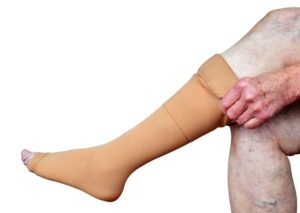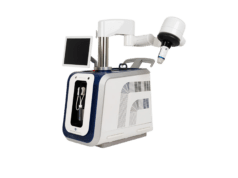 A systematic review and meta-analysis published online in the European Journal of Vascular and Endovascular Surgery has suggested that, following endovenous thermal ablation of varicose veins, compression stockings only slightly reduce pain with no significant improvement to quality of life (QoL).
A systematic review and meta-analysis published online in the European Journal of Vascular and Endovascular Surgery has suggested that, following endovenous thermal ablation of varicose veins, compression stockings only slightly reduce pain with no significant improvement to quality of life (QoL).
Authors Huanrui Hu (West China Hospital of Sichuan University, Chengdu, China) and colleagues write that compression socks are used to reduce the risk and progression of venous disorders such as deep vein thrombosis (DVT), as well as to minimise the risk of complications such as haemorrhage following surgical treatment for varicose veins. Despite compression socks being recommended after this traditional surgical procedure, the authors state that there is currently only weak evidence to suggest there is no great benefit to their addition.
In order to address this gap in the literature, Hu et al carried out a meta-analysis of seven randomised controlled trials (RCTs). Data were collected from numerous electronic databases such as MEDLINE, EMBASE and the Cochrane Library from inception to 10 March 2021, resulting in data from 1,146 patients. The data originated from RCTs that compared outcomes between patients who received compression therapy and those who did not following either radiofrequency ablation or endovenous laser ablation of varicose veins. However, studies were excluded if the compression therapy duration was shorter than one week.
To assess the potential benefits of compression stockings, the study’s primary endpoint was QoL, which was assessed through the Aberdeen varicose vein questionnaire (AVVQ). Postoperative pain was a secondary endpoint, which was assessed using the 100mm visual analogue scale (VAS), with deep vein thrombosis and superficial thrombophlebitis as major complications. Minor complications were considered to be infection, haematoma, blisters and paraesthesia.
The researchers identified 970 records in total, of which eight reached the inclusion criteria. Within these eight studies, only seven were analysed due to one report presenting too short a compression therapy duration. A total of five studies, incorporating 840 patients (423 with compression, 417 without compression), reported AVVQ data.
Hu and colleagues report in EJVES that there were no significant differences in the QoL between the two groups and that post-procedural compression did not result in significant improvement (95% confidence interval [Cl] 0.05–0.22, p=0.21). A total of 1,104 patients recorded lower pain scores compared to those with no compression (95% Cl -12.01–-3.99, p<0.001). Additionally, target vein occlusion rates were evaluated by venous duplex ultrasound and reported in five trials. In the compression group (n=255) and the no compression group (n=260), the combined occlusion rate was 97.3% and 98.5%, respectively. Therefore, no significant differences in the occlusion rate between compression groups were found (95% Cl 0.96–1.02, p=0.44), the investigators relay.
Major and minor complications were reported within six and four studies, respectively. Among the patients with compression (n=455), seven reportedly developed major complications, as did 11 of those without compression. There were therefore no significant differences between the groups (95% Cl 0.26–1.59, p=0.34) and postoperative compression did not reduce the incidence of minor complications significantly 95% CI 0.68–1.21, p=0.53).
In concluding, Hu et al propose that the use of compression socks is not associated with significant improvements in pain, QoL and complications and therefore bring no benefit following endovenous thermal ablation of varicose veins. However, they note that whether the rate of recurrence of varicosities after endovenous thermal treatment is associated with wearing compression stockings deserves further investigation.













I didn’t find a link to the original publication, here it is:
https://www.ejves.com/article/S1078-5884(21)00773-5/fulltext